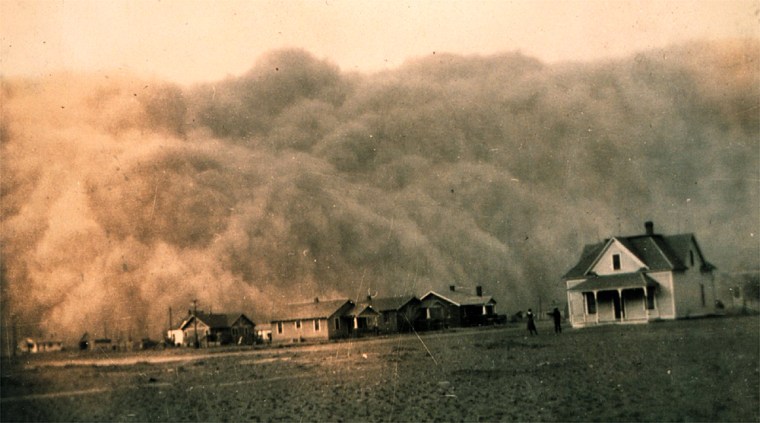The Dust Bowl drought of the 1930s, described in Steinbeck’s famous novel, produced fearsome “black blizzards” of dust that drove the Great Plains farmers on a desperate migration out west. Could such a severe drought happen again? It’s been hard to say, since we haven’t known what caused the dry spell in the first place.
Siegfried Schubert and his colleagues at NASA’s Goddard Space Flight Center now have an explanation for what caused the Dust Bowl drought. Although it's impossible to predict the precise timetable, history suggests that another great drought could certainly occur in the future.
The first step for anyone wanting to gauge the risk of a future catastrophic climate event is to look into the past. Unfortunately, good records of rainfall only go back about 100 years, and useful atmospheric measurements only exist for the last 50 years or so.
With such short records, it’s impossible to tell whether a decade-long drought is a freak occurrence or something that happens at least once per century. Likewise, if you found a four-leaf clover after searching through just a square foot of grass, you would need more information to know whether you had discovered a weed or a rare treasure.
Knowing the cause of the Dust Bowl doesn’t automatically reveal when the next one might occur, but it offers valuable clues. Fortunately, researchers have developed sophisticated climate models that simulate the myriad processes involved in producing phenomena like drought.
“The precipitation record is too short to say much about long-term droughts using statistical techniques. It’s only through these modeling studies that you can get at that question,” Schubert said.
Climate researchers also have another type of record at their disposal: Ships have been recording sea surface temperatures for more than 150 years. Before Schubert’s team began their study, other researchers had noticed that droughts tended to be accompanied by unusual sea surface temperatures in other parts of the world.
From the tropics with love
The scientists used the model to run a simulation of the 20th century’s climate patterns. After setting starting conditions, they let the model run on its own, “forced” only by the observed monthly global sea surface temperatures. (In fact, they ran 14 different simulations and averaged them together as a way to eliminate random climate variations, or “noise,” generated by the model.)
The model was able to reconstruct the Dust Bowl drought quite closely, providing strong evidence that sea surface temperatures drove the drought.
In the model, the sea surface temperatures most tightly linked to the drought were in the tropical Atlantic, where the waters were slightly warmer than usual, and in the tropical Pacific, where they were slightly cooler. The actual temperature differences were small: just a few tenths of a degree Celsius.
The changes in the tropical Atlantic probably contributed to the drought by disrupting a band of low-lying air that blows moisture over the Great Plains from the Gulf of Mexico, according to Schubert. The role of temperatures in the tropical Pacific is still not well-understood, but it appears to involve the generation of large-scale circulation patterns that suppress rising motion (and therefore precipitation) over the Great Plains.
Interactions between the Great Plains land surface and the atmosphere also played a role in the drought, the authors found.
“The drought wasn’t just about inhibiting the transport of moisture from afar. Local soil moisture was also a critical part of the picture. If the soil dries out, less evaporation occurs, and this can help suppress precipitation,” Schubert explained.
Another Dust Bowl?
It didn’t take much of a change in tropical sea surface temperatures to produce the Dust Bowl drought, but Schubert is hesitant to speculate on future droughts.
Climate models don’t actually predict sea surface temperatures for more than a year into the future. More importantly, we don’t know enough about how our pumping greenhouse gases into the atmosphere affects ocean temperatures or other components of the climate system.
“Part of the problem is that we’re now in uncharted territory. There has been a general trend of warming in both oceans in recent times. The trend is fairly unique when you look at the last 100 years or more,” Schubert said.
A look backward, however, suggests that droughts have made fairly regular appearances on the climate scene.
North America experienced a dry spell during the 1950s and again in the late 1980s. And, the researchers’ model results suggest we came quite close to having a drought in the 1970s. Some random “noise” in the actual climate seems to have led us down a happier path.
On a longer time scale, tree rings, sediment records and other proxy evidence of climate change indicate that the Great Plains has experienced multiple droughts lasting much longer than the Dust Bowl did.
These severe events seem to have occurred approximately once or twice a century over the last 400 years. Some evidence even suggests droughts lasting more than a decade during the late 13th and 16th centuries that were much more severe than those of the 20th century, according to Schubert.
“Certainly history suggests that we can expect much worse than we got in the 1930s, but given that warming seems to be unique in last few decades, it’s difficult to say what the impact of that will be,” he said.
In the next few years, Schubert predicted, improved climate models and global satellite observations should lead to useful predictions of the chances of long-term drought.
Visit for more mysteries of the universe from the journal Science.
